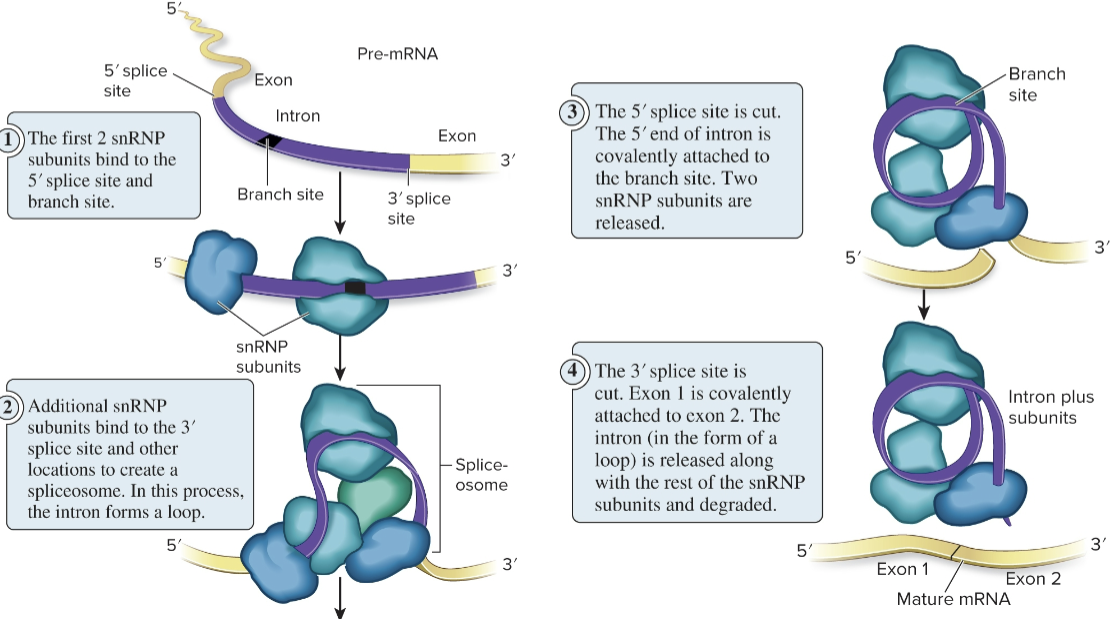biolA 190 - ch 10
1/51
There's no tags or description
Looks like no tags are added yet.
Name | Mastery | Learn | Test | Matching | Spaced |
|---|
No study sessions yet.
52 Terms
10.1
10.1
at the molecular level, transcription and translation are
key processes of gene expression
central dogma
describes information flow from DNA to RNA to protein
genes provide a
“blueprint” for the characteristics of organisms
10.2
10.2
DNA stores information
This information must be accessed at the molecular level for genes to be expressed
gene
an organized unit of nucleotide sequences that enables a segment of DNA to be transcribed into RNA
results in the formation of a functional product
the functional product is often a
protein
can also be an RNA molecule
a gene is composed of specific base sequences organized in a way that
allows the DNA to be transcribed into RNA
important sequences
promoter
transcribed region
terminator
regulatory sequences
transcription occurs in 3 stages
initiation
a recognition step where the promoter functions as a recognition site
bacteria: sigma factor binds to RNA polymerase
elongation
occurs as RNA polymerase synthesizes RNA
DNA template strand
opposite DNA strand is called the coding strand
termination
occurs when RNA polymerase reaches a terminator, releases the transcript, and dissociates from DNA
basic features of transcription are similar among all organisms
promoter, initiation, elongation, and termination stages
transcription of eukaryotic genes involves
more complexity of protein components
10.3
10.3
in eukaryotes, the product of transcription is a
pre-mRNA, an immature precursor that must be processed to form a mature mRNA
pre-mRNAs undergo 3 key modifications
A 5’ cap is added
a 3’ poly A tail is added
during splicing, the introns are removed and the exons are connected together
the 5’ cap is recognized by a variety of proteins
it is needed for the mRNA to exit the nucleus and bind to the ribosome
the poly A tail increases
the stability of the mRNA in the cytosol
spliceosome
complex that precisely removes introns
snRNP
contains small nuclear RNA and a set of proteins
alternating splicing
allows complex eukaryotes to use the same gene to make different proteins
splicing occurs in a series of steps
and the catalytic events of steps 3 and 4 are catalyzed by an RNA component (ribozyme activity)

10.4
10.4
genetic code
specifies the relationship between the sequence of nucleotides in the mRNA and the sequence of amino acids in a polypeptide
the code is read in groups of 3 nucleotides called codons
64 codons, 1 start codon, 3 stop codons
the code is redundant
more than one codon can specify the same amino acid
key components for translation
ribosomal-binding site
start codon
coding sequence
stop codon
start codon
AUG
stop codons
UAA
UAG
UGA
the start codon redefines the reading frame
groups of 3 nucleotides that are “read“ as codons
codons are read in a
sequential and non-overlapping manner in the 5’ to 3’ direction
scan for thet start codon AUG after
the ribosomal binding site to begin
transfer RNAs
tRNAs - are involved in translating the nucleotide base sequence of the mRNA into the amino acid sequence of the polypeptide
Different tRNAs have different
anticodon sequences and each tRNA carries a specific amino acid
10.5
10.5
the tRNAs of all species share common features
anticodon
animo acid attatchment site
cells make many different tRNAs
each encoded by a different gene
The enzymes that catalyze the attachment of amino acids to tRNA molecules are
aminoacyl-tRNA synthetases
ribosomes
the sites of translation
ribosomes contain 3 discrete sites where tRNA may be located
aminoacyl (A) site
peptidyl (P) site
exit (E) site
the gene for small subunits rRNA is found in
all species
if 2 species diverged a long time ago their gene sequences are quite different whereas
if they diverged a short time ago, their gene sequences are more similar
10.6
10.6
like transcription, translation occurs in
3 stages: initiation, elongation, termination
initiation
an mRNA, the first tRNA, and the ribosomal subunits assemble into a complex
initiation factors
proteins that help assemble the mRNA , tRNA, and ribosome int a functional complex; hydrolysis of GTP provides an input of energy
the first tRNA carries a modified
methionine and resides in the P site
initiation of translation differs in a few ways
The cap is recognized by proteins that promote the binding of the mRNA to the small subunit
the elongation stage involved
covalently bonding of amino acids to each other
termination
occurs when a stop codon is reached
(UAA, UAG, UGA) are recognized by a protein called a release factor, NOT a tRNA